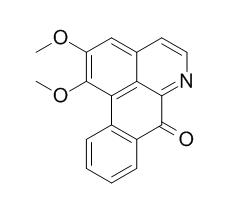Lysicamine
Lysicamine shows significant antioxidant capacity in the ORAC(FL) assay and it is active against S. epidermidis and C. dubliniensis, with MIC values in the range 12.5-100 microg mL(-1). Lysicamine has antimicrobial and anti-inflammation activity, the minimum inhibitory concentrations of the pour component (Streptococcus mutans, Porphyromonas gingivalis, Actinobacillus actinomycetemcomitans and Candida albicans.) is less than 5mg/ml for all four microorganisms and the minimum concentration with anti-inflammation is 0.2mg/ml for both IL-8 and IL-6. Lysicamine has antileishmanial activity. It can significantly inhibit the proliferation of melanoma cells, it has antioxidative activity and chemopreventive activity in skin melanoma cells.
Inquire / Order:
manager@chemfaces.com
Technical Inquiries:
service@chemfaces.com
Tel:
+86-27-84237783
Fax:
+86-27-84254680
Address:
1 Building, No. 83, CheCheng Rd., Wuhan Economic and Technological Development Zone, Wuhan, Hubei 430056, PRC
Providing storage is as stated on the product vial and the vial is kept tightly sealed, the product can be stored for up to
24 months(2-8C).
Wherever possible, you should prepare and use solutions on the same day. However, if you need to make up stock solutions in advance, we recommend that you store the solution as aliquots in tightly sealed vials at -20C. Generally, these will be useable for up to two weeks. Before use, and prior to opening the vial we recommend that you allow your product to equilibrate to room temperature for at least 1 hour.
Need more advice on solubility, usage and handling? Please email to: service@chemfaces.com
The packaging of the product may have turned upside down during transportation, resulting in the natural compounds adhering to the neck or cap of the vial. take the vial out of its packaging and gently shake to let the compounds fall to the bottom of the vial. for liquid products, centrifuge at 200-500 RPM to gather the liquid at the bottom of the vial. try to avoid loss or contamination during handling.
Pol J Microbiol.2021, 70(1):117-130.
The Journal of Phytopharmacology2020, 9(1): 1-4
J Pharm Pharmacol.2023, 75(9):1225-1236.
Molecules. 2013, 18(7):7376-88
Int J Vet Sci Med.2024, 12(1):134-147.
GxABT2022, 2268.2:15515.
Phytother Res.2019, 33(5):1490-1500
Cancers (Basel).2023, 15(1):293.
Phytochem Anal.2016, 27(5):296-303
Animals (Basel).2024, 14(20):2990.
Related and Featured Products
Applied Mechanics & Materials, 2011, 108:189-93.
Lysicamine in a Lotus Leaves Extract May Be Responsible for Antibacterial and Anti-Inflammation Activity[Reference:
WebLink]
METHODS AND RESULTS:
In the course of a search for chemotherapeutic agents inhibiting suspected peridontitis bacteria, extracted and purified substances from lotus leaf were identified by antimicrobial and Anti-inflammation activity tests with use of the broth micro-dilution methods on 96-microwell plate and ELISA assay. The antimicrobial activity of extracts was tested against four microorganisms, namely: Streptococcus mutans , Porphyromonas gingivalis, Actinobacillus actinomycetemcomitans and Candida albicans. The Anti-inflammation activity of extracts was tested for inhibition of inflammatory cytokines IL-8 and IL-6 in macrophage BF24. And one pure component was subjected to spectroscopic analysis using UV, IR, EMI-MS, EIMS, 1H-NMR, 13C-NMR, 1H-COSY and HMQC. Our data showed that the minimum inhibitory concentrations of the pour component was less than 5mg/ml for all four microorganisms and the minimum concentration with anti-inflammation was 0.2mg/ml for both IL-8 and IL-6. The component was determined to be Lysicamine.
CONCLUSIONS:
Thus, we conclude that Lysicamine extracted from lotus leaves may be a potential antibacterial and Anti-inflammation agent for oral infection.
Molecules, 2014, 19(4):4234-45.
Antioxidant and anticancer constituents from the leaves of Liriodendron tulipifera.[Pubmed:
24705566 ]
METHODS AND RESULTS:
Sixteen compounds were extracted and purified from the leaves of Liriodendron tulipifera. These compounds include aporphines, oxoaporphine, coumarin, sesquiterpene lactone, benzenoids, cyclitol and steroids. (+)-Norstephalagine (2) (an aporphine) and scopoletin (8) (a coumarin) were isolated from Liriodendron tulipifera leaves from the first time. The identified compounds were screened for their antiradical scavenging, metal chelating and ferric reducing power activities. The results have showed that these compounds have antioxidative activity. The study has also examined the chemopreventive property of the isolated compounds against human melanoma cells A375. The results shown that (-)-anonaine (1), (-)-liridinine (3), (+)-lirinidine (6), Lysicamine (7) and epitulipinolide diepoxide (9) significantly inhibited the proliferation of melanoma cells.
CONCLUSIONS:
These results revealed that these compounds have antioxidative activity and chemopreventive activity in skin melanoma cells.
Brazilian Meeting on Organic Synthesis. 2013:114-114.
Study toward the total synthesis of lysicamine: an aporphine alkaloid with antileishmanial activity[Reference:
WebLink]
METHODS AND RESULTS:
Benzyne can be considered a highly reactive intermediate with application in reactions of insertion into sigma bonds and also in cycloaddition reactions, which have been broadly employed in total syntheses of bioactive natural products and in preparations of functional materials.
CONCLUSIONS:
Accordingly, we intend to accomplish the total synthesis of aporphine alkaloid named Lysicamine (1), a compound with antileishmanial activity, employing strategy which has as key step the [4+2] cycloaddition reaction between 1-methylene-1,2,3,4- tetrahydroisoquinoline (3) and benzyne (7), generated from 2-(trimethylsilyl)phenyl triflate (8), under mild reaction conditions.



